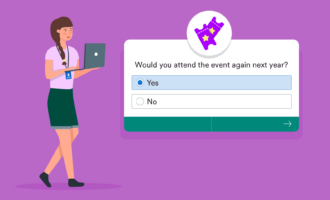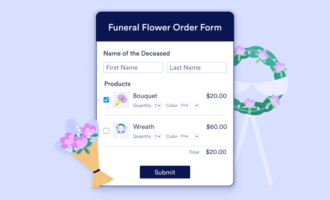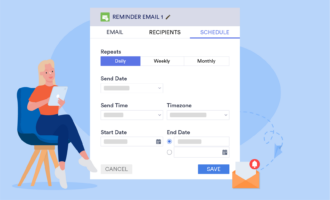The key to hosting a successful event is having a thoughtful plan. It’s easy to become overwhelmed at the thought of planning an event. But if you stick to this simple four-step plan, you’ll be able to prepare for your event with ease.
In order to maintain an efficient planning process, you should
- Determine your goals
- Brand your event
- Market your event
- Create an online registration form
Are you ready to explore the essentials of putting on a great event? Let’s get started.
1. Determine your goals
The first step in planning an event is to look at your goals. What are you trying to accomplish with this event? Take the time to list your goals so that you can keep them in mind as you move forward with other decisions.
There are a few key concepts that factor into determining your goals, so even before securing your venue and date, you should consider
- Your attendance goals. How many attendees do you need or want at the event? Will you need volunteers to keep everything running smoothly? Think about the size and nature of your event, and who your target audience is. From there, you can start to build on those numbers and orchestrate an event that works with them.
- Your activities. What kind of speakers or panelists do you want at your event? What kinds of activities should you plan? If you’re a nonprofit running a fundraiser, should you include a silent auction? If this is a corporate event, should you reach out to thought leaders in the industry to present a lecture? Be sure to tailor your activities to your audience and industry.
- Your budget. Think about how much money you want to put into this event, and how much money you need. Consider fundraising if you need to raise money in order to successfully run the event.
- Your past events. How have your past events performed? Which marketing strategies worked best? Use feedback from previous events to help you make adjustments to this event. Take a look at your past events to see which activities were most popular, and use all of this information to tailor your plan accordingly.
Taking a moment (or two) to step back and evaluate your goals is an important part of planning a successful event. Before you can move on, you need to have a clear idea of the audience you’re tailoring your event to, how much money you need to put into the event, and how your events have done in the past as a point of comparison.
2. Brand your event
One of the biggest things that can make or break your event is your branding. If you don’t have a compelling name or theme, you won’t grab as much attention and may miss your attendance goals. Be sure to set your event apart from others in your industry and communicate your event’s objective clearly.
Whether this means giving away swag bags with custom merchandise or deciding what message your event should convey, the way you organize your branding is key. A few factors you should keep in mind are
- A name and tagline. Think of names that will make your event stand out, and include a tagline that describes what the event is about. Keep it short but informative.
- A logo. To make your event immediately recognizable, design a logo that can be used on promotional materials (t-shirts, bags, etc.). If you’re not confident in your design skills, you can hire a freelancer on sites like Fiverr to create a logo for you.
- Custom merch. Once you have your logo and other parts of your branding in place, work on your overall brand awareness. For instance, look for a service that allows you to design, print, and order custom t-shirts for the event. You can even offer a free t-shirt for the first 50 registrants, which will help promote your business outside of the event and benefit future events, too.
Branding your event is important because it makes the event stand on its own. By having a consistent look and feel, which covers everything from your logo to your merch and even the name of the event, you’re providing attendees with a unique experience that they’ll be sure to remember.
3. Market your event
If you don’t market your event, no one will attend. There are several ways to put together an efficient and effective outreach strategy without overextending yourself. Take advantage of multiple platforms to quickly spread the word about your event by using
- Social media. This is the ultimate platform for marketing. If you haven’t already, create a Facebook page for your business or organization, and then create a specific event page that offers information about your event and includes a link to the registration form. Design a Facebook banner that features your tagline, or make a hashtag for your event that you and your community can share on Twitter or Instagram. All of these efforts can help get your event trending and keep it on people’s minds.
- Email marketing. This is a tried-and-true method of reaching more people. If you have a CRM database, keep it up to date, and use it to track email addresses and send out messages about your event. In the message template, include a link to register, as well as other helpful information attendees will need to know, such as the date and time of the event.
- Traditional marketing. Be sure to use traditional marketing in addition to online efforts for people who aren’t online. Running newspaper ads and leaving flyers at local businesses are great ways to spread the word if your event has a local or broader public appeal.
- Sponsors. Early on in your planning process, you should determine any partners or sponsors who are going to be involved with your event. Once you have a mutual agreement, you’ll typically include their information and logos in your marketing materials, such as emails, t-shirts, and brochures. Be sure you understand what both sides expect from the sponsorship.
- Keep your content updated and relevant. It’s a marathon — not a sprint. Part of marketing your event means keeping your content up to date and producing a continuous stream of content about your organization or business. Keep your website and calendar updated with the event information as well. If you continuously reach out to and connect with people, they’ll become more familiar with you on the whole, which will make them more likely to register for your event.
Marketing can take many forms, but all methods can be effective if you use them with intention and thought. When deciding how you want to reach out to your potential attendees, make sure you keep your audience in mind. You need to know what platforms they’re using. From there, you can determine the most effective way of reaching out to them.
4. Create an online registration form
One of the topics we’ve briefly touched on is event registration. Part of your branding and marketing includes having an easy-to-use registration form that not only allows your attendees to register but also lets you obtain necessary information from them.
In order to create a seamless process for you and your event registrants, you should
- Use an intuitive template. Find a form template that features all the fields you need to collect registrant info and keep it organized. Don’t include too many fields in your form; if you do, the form will be tedious to fill out.
- Keep the form consistent with your branding. Use a template that you can customize with your logo or other imagery that aligns with your brand and the branding of the event itself. Doing this reassures your attendees that they’re in the right place and builds trust.
- Integrate the form with a payment processor. Be sure to use a form that can integrate with payment processors, should you need to collect a registration fee for the event. Keeping everything you need in one place makes for a seamless process for both you and your attendees.
The online registration form is your attendees’ first impression of your event and your organization. Make it count and encourage people to register with a branded, intuitive, and clean form. From there, you’ll be on your way to putting on a great event!
Simplify the complexity of event planning with a tried-and-true planning strategy. When you keep your goals, audience, and marketing initiatives at the forefront of your plans, you’re setting yourself up for success. Now that you have an idea of what practices work best, take a stab at them yourself and get your event moving!































































Send Comment: